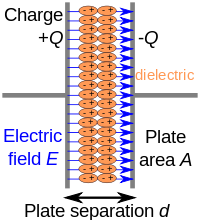
Photo from wikipedia
The influence of silver nanoparticles dispersed in a Ferroelectric Liquid Crystal (FLC) on the properties of the resultant composite system has been investigated by thermal, electro–optical, and dielectric methods. We… Click to show full abstract
The influence of silver nanoparticles dispersed in a Ferroelectric Liquid Crystal (FLC) on the properties of the resultant composite system has been investigated by thermal, electro–optical, and dielectric methods. We show that the concentration of thiol capped silver nanoparticles is a critical factor in governing the alignment of nanoparticles (NPs) in the host FLC. The orientation of NPs in composite samples affects the ordering of the LC (Liquid Crystal) phase and consequently changes the various phase transition temperatures of the host LC. Formation of self-assembled 2D (two dimensional) arrays of nanoparticles is observed for high concentration of dopant in the LC, oriented perpendicular to the direction of rubbing. We propose that the molecular interaction between the thiol capped NPs and LC molecules is the key factor behind such an arrangement of NPs. Orientation of NPs has affected the relaxation behaviour and various other material parameters, significantly. A noteworthy change in DC conductivity articulates our proposed idea of the formation of 2D array of NPs perpendicular to the direction of rubbing. This comprehensive study endorses the importance of dopant concentration in modifying the properties of the host LC material.The influence of silver nanoparticles dispersed in a Ferroelectric Liquid Crystal (FLC) on the properties of the resultant composite system has been investigated by thermal, electro–optical, and dielectric methods. We show that the concentration of thiol capped silver nanoparticles is a critical factor in governing the alignment of nanoparticles (NPs) in the host FLC. The orientation of NPs in composite samples affects the ordering of the LC (Liquid Crystal) phase and consequently changes the various phase transition temperatures of the host LC. Formation of self-assembled 2D (two dimensional) arrays of nanoparticles is observed for high concentration of dopant in the LC, oriented perpendicular to the direction of rubbing. We propose that the molecular interaction between the thiol capped NPs and LC molecules is the key factor behind such an arrangement of NPs. Orientation of NPs has affected the relaxation behaviour and various other material parameters, significantly. A noteworthy change in DC conductiv...
Journal Title: Journal of Applied Physics
Year Published: 2017
Link to full text (if available)
Share on Social Media: Sign Up to like & get
recommendations!